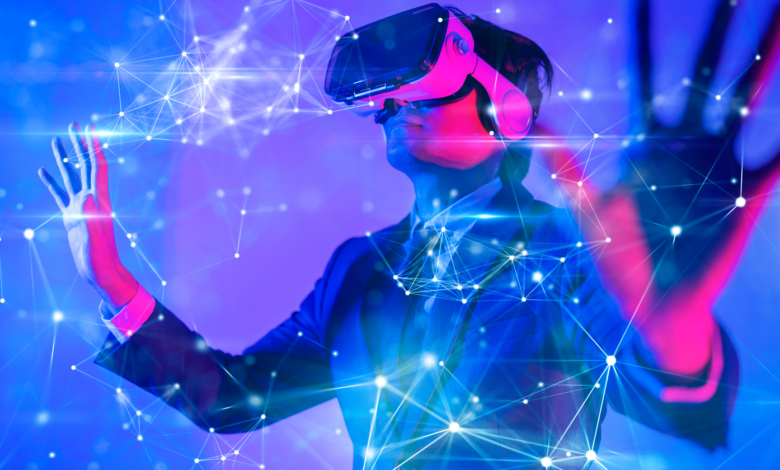Metaverse Primer For Marketers: How We Got Here & Where We Go Next

Although the Metaverse’s infrastructure is still being built, companies and brands are jumping at the chance to join this new world.
So if they’re on board, how close are we to turning the metaverse into a full reality?
We’ve seen many changes in our society over the past few years, but nothing holds the potential for change quite like the Metaverse.
Last fall, when Mark Zuckerberg announced Facebook’s new parent company, Meta, talk of the future societal implications of such an immersive social platform swept the world.
And for good reason.
Virtual reality, augmented reality, smart glasses, social media, and cryptocurrency have been around as separate but related ideas so far.
Metaverse combines these moving parts to create a powerful tool for businesses and marketers alike.
Zuckerburg announced Meta as a “social technology company” with a clear focus on social responsibility that will change the way people work, socialize, and experience the world around them.
Ordinary physical boundaries do not limit this world, and therein lies its appeal to those seeking greater global reach.
But where did this concept come from, and where is it heading?
Let’s find out.
Metaverse history
The term “metaverse” was first used by science fiction writer Neil Stephenson to describe a three-dimensional virtual reality that people can, in a sense, occupy. It was more theoretical than practical.
But in 2022, life will begin. It is an immersive digital environment populated by virtual avatars that represent real people.
In the Metaverse, you can carry out many daily interactions and events in your daily life – in the form of your own avatar.
This model can be a human, an animal, or something more abstract with its customizable look.
You can then interact with other people’s avatars in this virtual world. In the Metaverse, you can buy and sell land, attend concerts, go to museums, build a house, and more.
In many ways, the Metaverse picks up where games like Second Life began in 2003.
This creates a whole other level of interdependence and another dimension to our global economy.
How virtual reality started with online games
The concept of virtual reality and augmented reality has been steadily leaking into mainstream culture over the past 20 years. The gaming industry was the first to really take advantage of it and incorporate it into their platforms.
Games like Pokémon Go (2016) and Fortnite (2017) are all about using these technologies to connect people through their apps.
Pokémon Go is one of the biggest and most successful augmented reality games in the industry.
When it exploded in popularity in 2016, it ushered in a new era of the integration of augmented reality into our daily lives.
Fortnite, the virtual reality game that uses avatars to represent players, lets people fight against each other in real time and attend events that take place in that specific metaverse.
These two hugely popular games helped introduce the community to the concept of “Extended Reality” (XR).
Extended or mixed reality (XR) refers to all events that combine some elements of the real and the virtual.
This includes forms of augmented reality (AR) and virtual reality (VR).
XR creates a more immersive experience for users and blurs the boundaries between reality and what technology generates.
This combination of facts creates endless possibilities for integration of different technologies to create a more comprehensive and immersive experience for users.
How you made the Cryptocurrency Metaverse possible
Because the Metaverse is virtual, it is always active, self-sustaining, and creates incredible business possibilities. And many of these possibilities have a basis in cryptocurrency.
The advent of Bitcoin in 2009, coupled with the growing popularity of cryptocurrencies over the past decade ushered in a new era in which finance did not have to be physical.
With the recent rise in popularity in Ethereum and NFTs, cryptocurrencies are becoming a more legitimate form of financial exchange for the entire world – especially for investors and business leaders who are always on the horizon for new directions.
Conversations about these currencies will become more prevalent in the coming years.
Virtual currency only complements this already virtual world and gives everyone in the metaverse purchasing power. Companies are noticing and following suit.
How do big brands get involved?
Some of the companies preparing for the Metaverse include big names like Nike, Adidas, and Vans.
In October of 2021, Nike filed several trademark applications for their iconic logos and icons (such as “Just Do It” and the iconic check mark), which will allow them to make and sell virtual goods.
This happened in conjunction with Mark Zuckerberg’s meta announcement.
In December last year, Nike announced the acquisition of the studios of the virtual shoe company RTFKT, which will help them create shoes for sale in the Metaverse. This is incredible news for sneaker fans everywhere.
Adidas is making its foray into the Metaverse with Collaborative NFT projects (which has since sold out), creating exclusive collectibles with other artists.
NFTs en masse Sold for more than $22 million. They have affirmed the NFT community by investing in NFTs as a company and have bought a large plot of land in the metaverse to host virtual parties and events.
It is one of the first companies to not only launch NFTs, but actually invest in the Metaverse ecosystem itself.
Vans is also involved.
The company has built an online skate park that is already seen up 48 million visitors.
This kind of engagement is like no other. Personal events simply cannot accommodate the same capacity as people.
Customers can also shop in their virtual store to earn points and customize their avatar.
Brands don’t just dip their toes in the water — they dive in.
It’s time for others to follow suit.
The Metaverse is closer than ever — in fact, it’s already out there
The Metaverse infrastructure is still being built, but companies and brands are jumping at the chance to be a part of this new world.
So, if they’re on board, how close are we to turning the Metaverse into a full reality?
What are the potential effects of the Metaverse on society as a whole, but specifically, the way we do business?
Mixed reality, virtual conferences and conventions
The pandemic has propelled society into a new era of digital innovation and created a huge need for advanced technologies that would allow us to continue our daily business efforts from home.
Companies that depend on conferences and trade shows have had to pivot quickly.
The Metaverse provides ample opportunities for businesses to meet through virtual reality, saving businesses and attendees money on travel, lodging, and other related costs.
Staff and participants can wear virtual reality glasses from the comfort of their own home, as if they were there.
Bands and artists can host virtual concerts from anywhere in the world. The potential uses are nothing short of revolutionary.
Targeting millennials and generation z
Targeting millennials and generation Z is of utmost importance for brands.
The original Gen Z digitally proved difficult to market. They have an intuitive understanding of technology not seen in previous generations.
They are also more waterlogged than most other age groups.
According to some reports, Generation Z is the digital life No less important than the physical. For some, there is little differentiation.
The virtual world and social media are not separate lives but additional extensions of their more present physical reality.
It also brings friendships around the world closer to the current reality and means getting to know brands they might not normally discover.
This is characterized by a dual effect on the marketing and selling potential of brands – exposure is unlimited due to physical limitations, and physical and digital goods become equal players in value.
According to the example of Nike, the virtual shoe is no less valuable because it is in the digital realm – it has the power to compete (and it will not have to be cleaned with a toothbrush).
If a brand’s target audience is going digital, it’s no surprise that brands seek digital innovation to compete.
Now is the time for brands to see what possibilities Metaverse can open up for them.
Early stage adopters will only be rewarded in the long run.
A deeper level of customer loyalty
Metaverse never sleeps. It’s in the loop 24/7 of information and interaction.
Marketers need to develop a real-time, on-the-ground approach to customer loyalty to continue to succeed amidst these endless choices for consumers.
Getting to a deeper level of customer loyalty and relationship marketing may seem like a no-brainer, but it’s a challenge to some.
Metaverse is less likely to replace your current marketing strategy than it will complement it.
Brands must remain true to those in an entirely digital space. I know this from experience at AdRoll.
Our company platform deploys machine learning to help brands build loyalty in e-commerce.
In helping thousands of brands build customer loyalty, I can confirm that success in this area doesn’t come from technology alone, no matter how advanced it may be – and the same principle applies in the Metaverse.
Once the Metaverse is up and running in its entirety, it will be more difficult than ever to win new customers.
If your company has the bandwidth and resources, start focusing on creating a very loyal customer base that will follow you through the Metaverse as it grows and develops.
Is the average consumer really ready?
Metaverse will push marketing and most of society deeper into digital innovation and immersion.
But are consumers ready? Early adopters may be eager to try, but what about those who are more hesitant?
It will take time for technology to become more integrated with everyday life and society as a whole.
If you create something your target audience wants to be a part of, you will find success. Don’t join the Metaverse just to join it: make sure you have something to offer.
Create a sense of community, and more reluctant participants will trust you enough to follow you.
What can you expect from the Metaverse in 2022
In 2022, you can expect more devices to reach consumers every day. Apple has already invested in augmented realityand their virtual reality headset will be released later this year, with rumors of VR contact lenses circulating in recent weeks.
The creators of Pokémon Go are dabbling in augmented reality gear, too.
Brands like Burberry and Gucci are already advertising and selling virtual goods using augmented and virtual reality. New hardware launches are scheduled for later this year.
Volumetric video is now more integrated into shopping experiences and some work-related events.
Buying virtual lands in the Metaverse is on the rise, and some expect to reap millions (if not billions) in revenue. Honestly, it’s not just a trend — it’s here to stay.
Marketers should pay close attention to the evolution and evolution of the Metaverse.
Skeptics may miss a great deal of digital innovation that is set to change the way society does business and functions as a whole.
More resources:
- Marketing in the Metaverse: The Future of Search and Social Networking
- Metaverse Marketing [Podcast]
- Social Media Marketing: A Complete Strategy Guide
Featured image: thinkhubstudio / Shutterstock




